Robert Lovell Gwatkin
Robert Lovell Gwatkin (1757–1843) was an English landowner, High Sheriff of Cornwall in 1789.[1]
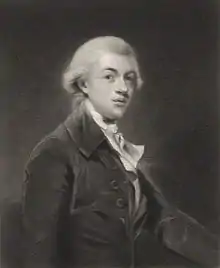
Early life
He was the son of Edward Gwatkin (died 1764), a merchant in Bristol, and his wife Ann(e) Lovell. Ann Lovell Gwatkin came to know Hannah More, at school with her daughter, and became an important supporter. His father's will, in which Edward Gwatkin describes himself as a soapmaker, made Robert Lovell Gwatkin his residual legatee at age 21. He was an heir also, on his mother's side, to the family of Bedford of Launceston.[2][3][4][5] Gwatkin's sister, Charlotte Ann, married William Gregor.[6] His three younger brother were John, a Royal Navy officer, Edward, a solicitor who married Octavia, daughter of George Harnage, 1st Baronet, (or of Henry Harnage of the 62nd Regiment)[7][8] and Thomas who died unmarried.[9][10]
Gwatkin was admitted to the Middle Temple on 21 May 1774, and to St John's College, Cambridge two days later. There he graduated B.A. in 1778, and M.A. by royal mandate the same year.[11] He was a student friend of William Pitt the younger.[12][13] In 1779, during the American Revolutionary War, he was courting Theophila Palmer, his future wife. Fanny Burney, visiting the Reynoldses that year, found him very talkative with her, and no one else.[14] He also joined a militia camp defending Plymouth from a possible French invasion, with John Beauchamp and John Vivian, heading Cornish miners from Gwennap.[15]
Marriage and Killiow House
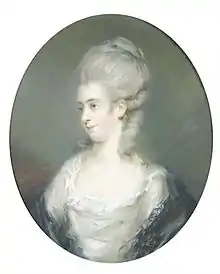
By his marriage in 1781 to Theophila, a niece of Sir Joshua Reynolds, Gwatkin became closely involved with the Reynolds family; his mother knew Frances Reynolds by the 1770s. He was chief mourner in 1792 at the funeral for Sir Joshua.[16][17] In his will, Reynolds left Theophila £10,000.[18]
Gwatkin resided at Kea, Cornwall, at Killiow, which he bought from the estate of David Haweis. He rebuilt the mansion there as Killiow House, remodelled externally in the mid-19th century but retaining much of the early 19th century interior, and now a grade II* listed building.[12][13][19][20] He was acquainted with Edmund Burke,[21] and James Boswell who visited Cornwall in 1792.[22] Maria Edgeworth described him as "Roast Beef of old England, king and constitution man."[23]
Also at Kea, Gwatkin had a new church built, All Hallows, on a changed site, to a design by James Wyatt; it was opened in 1802. His wife Theophila provided decorative painting. The design proved defective, however, with cracks appearing, and in 1869 it was decided to rebuild.[24][25] With a fund started in 1871 by the Rev. John Daubuz, the rebuilt church was opened in 1894, including a painted altar piece with angel heads by Theophila Gwatkin.[26]
The Cornwall survey of 1811 compiled by George Bouchier Worgan for the General View of Agriculture mentions Gwatkin a number of times as an improving farmer.[27] In March 1813 Killiow House, "late in the possession of Robert Lovell Gwatkin", was put up to let.[28] In "additions and corrections" to Magna Britannia (1814) it is described as "unoccupied".[29] The Bedford property included Tregarne, and Fursdon in Liskeard.[30][31] Gwatkin broke up the manor of Fursdon in 1813–4.[32] He also sold Advent in 1814, to Allen Searell.[33] In 1816, the Rev. Jeremiah Trist at Veryan, over the estuary from Kea, and whose daughter Charlotte married Gwatkin's son John, wrote of abatement of rents, debt and the distress of labourers affecting farming in his area of Cornwall.[34][35]
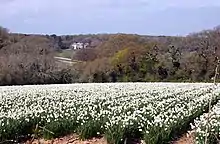
Later life
The Historical Survey of the County of Cornwall written by Charles Sandoe Gilbert and published 1817–20 said that Killiow house remained vacant, and Gwatkin, "one of the most respectable magistrates belonging to the county of Cornwall, has of late resided chiefly in Devon."[36]
Mary, Dowager Marchioness of Thomond, died on 6 September 1820; she was Theophila's sister.[37] Edward Gwatkin (1759–1832), Gwatkin's brother, had been a trustee of the wedding settlement of Mary and her husband, then Lord Inchiquin, since 1799. He already knew them socially, dining with them on 3 March 1794, as reported by James Boswell.[38][39][40] According to John Cam Hobhouse in his diary for 22 May 1821, covering a London dinner with Gwatkin, Gwatkin and his Palmer relations stood to benefit substantially from the sale of Reynolds pictures left by the Marchioness.[41] At this period Gwatkin is also placed in London by the diary of Joseph Farington.[42] The sale took place on 21 May 1821 and the following day.[43]
One of the Gwatkin daughters, Harriet, was engaged, though only for a short period in 1821, to John Herschel. Richard Gwatkin (born 1791, son of Thomas Gwatkin), a relation, was a friend of Herschel's, and an introduction may have taken place at his house.[44][45][46]
Henry William Pickersgill painted two portraits of Hannah More, and one was a commission from Gwatkin. The version in the National Portrait Gallery, London is dated 1822.[47][48] More left Gwatkin, in her will, the volumes of the Christian Oratory of Benjamin Bennet.[49]
In 1832 Gwatkin retired from the Cornish Club, which he had joined in 1782.[50] Around 1833, he moved to Plymouth, where he lived for the last ten years of his life.[12] The Daubuz family, owners of the nearby tin mine at Carvedras, Truro, built onto Killiow House.[51]
At the 1832 general election Gwatkin seconded Edward Wynne-Pendarves as candidate for Cornwall West, who had been proposed by Sir Hussey Vivian, remarking that he himself had been a reformer for 50 years.[52] At the West Cornwall county election meeting of 1835, he praised the Reform Act 1832.[53] For the 1837 general election, he addressed an election meeting to support the liberal candidates for East Cornwall, held in Devonport.[54] In 1841 he was part of a Plymouth deputation to Lord John Russell, with Thomas Gill the local Member of Parliament and others.[55]
Gwatkin died in Plymouth on 5 April 1843, aged 86, and was buried at Kea.[24]
Family
_Reynolds.jpg.webp)
Gwatkin married Theophila Palmer, daughter of John Palmer of Great Torrington and Mary Palmer (1716–1794), née Reynolds, sister of Sir Joshua Reynolds. She was known as "Offy", and had lived with the Reynolds family for a decade before the marriage, which took place in 1781.[56] Their children were:
- Edward (1784–1855), who became a Major-General in the Bengal Army, married Hetty Elizabeth Gascoigne. The artist John Reynolds Gwatkin (1807–1877) was their son.[57][58][59] Edward Gwatkin, the eldest son, died at sea on 13 April 1855, on board HMS Hotspur, after 50 years in India.[60]
- John, married Charlotte Fincher Trist.[58] He was a director of the Cornish Railway, and died in 1855.[61]
- Robert (c.1793–1821), married Miss Green,[58] died at Brompton in February 1821 at age 28[62]
- Theophila (1782–1844) married in 1816 at Meerut Robert Lowther, son of Col. Lowther MP, childless.[57][58][63][64] His second wife, whom he married in 1847 in Allahabad, was Laura Martindale.[65]
- Anne, died unmarried 1868,[58] or by March 1864 (if of 21, Princess Square, Plymouth)[66]
- Mary (1794–1879), third daughter, married in 1844 as his second wife Edward Beauchamp St John (died 1856)[67]
- Fanny, fourth daughter, died 1814[68]
- Harriet, married Major Edward Jones, Royal Marines, on 31 December 1839 in Plymouth.[58][69] She died at her father's house, in Princess Square, Plymouth, on 13 December 1840.[70]
- Elizabeth and Kate O'Brien, who with Fanny had no children.[58] There were no grandchildren, in fact, through the female lines.
Theophila Gwatkin often acted as a model for Reynolds, in pictures from Girl with a Muff to Comedy, according to family tradition, in Garrick between Comedy and Tragedy.[71] She was also an artist, who made copies of his works. Some attributions to her, such as copies of the "Cardinal Virtues" designed by Reynolds for stained glass in the chapel of New College, Oxford, have been challenged.[72] She wrote a work on Devonshire dialect.[73] She died at age 91, in 1848, at the rectory of her son-in-law Beauchamp St John.[74] Her will left a house in Princess Square, Plymouth to the daughters Anne Gwatkin and Mary St John.[75]
Reynolds legacy
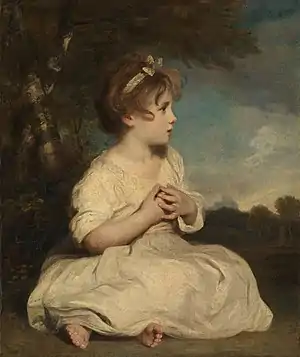
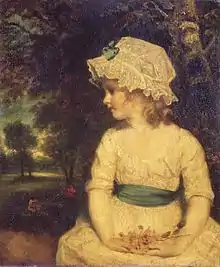
Gwatkin bought in 1821, after the death of his sister-in-law, the Marchioness of Thomond, two of the sketch-books of Reynolds, and had Joseph Skelton create facsimiles.[77] Editions of sketch-books were later published in works by William Cotton (1859), and as revised by Charles Robert Leslie with Tom Taylor.[78]
Benjamin Robert Haydon travelled in 1845 to Plymouth, to see Theophila Gwatkin and consult the Reynolds papers. He was researching the reason why Reynolds briefly resigned from the Royal Academy, in 1790.[79] She corrected some reminiscences of James Northcote of his life as a Reynolds apprentice.[80]
In the 1850s, 19 pocket books (sitter books) by Reynolds were owned by Miss Gwatkin of Princess Square, Plymouth.[81] She possessed a number of Reynolds portraits.[82] and she also passed on Reynolds's memoir of his friend Samuel Johnson, published by Leslie and Taylor.[83] Ledgers of Reynolds passed to Theophila and then John Reynolds Gwatkin. He sold them in 1873 to Henry Graves, who passed them to his son Algernon Graves. Charles Fairfax Murray bought them from Algernon Graves in 1904, and gave them to the Fitzwilliam Museum in 1916.[84]
Notes
- The Universal Magazine of Knowledge and Pleasure. Pub. for J. Hinton. 1789. p. 276.
- Gwatkin, Ellyn Margaret (1914). "Notes on families in Fownhope, Herefordshire and other places, named Gwatkin". Internet Archive. p. 55. Retrieved 19 June 2016.
- A Complete Parochial History of the County of Cornwall. W. Lake. 1870. pp. 91–2.
- Skedd, S. J. Oxford Dictionary of National Biography (online ed.). Oxford University Press. doi:10.1093/ref:odnb/19179. Missing or empty
|title=(help) (Subscription or UK public library membership required.) - Anne Stott (2003). Hannah More: The First Victorian. Oxford University Press. p. 9. ISBN 978-0-19-924532-1.
- Robert Forsyth Scott (1931). Admissions to the College of St. John the Evangelist in the University of Cambridge. College at the University Press. p. 279.
- A Genealogical and Heraldic Dictionary of the Peerage and Baronetage of the British Empire. Henry Colburn. 1869. p. 550.
- Barbara Lowe; Peter J. Marshall; John A. Woods (30 March 1978). The Correspondence of Edmund Burke: Volume 10, Index. Cambridge University Press. p. 340. ISBN 978-0-521-21024-9.
- Burke, Ashworth Peter (1897). Family Records. Internet Archive. 1. London: Harrison. p. 289. Retrieved 23 June 2016.
- John Bernard Burke (1845). A Genealogical and Heraldic Dictionary of the Peerage and Baronetage of the British Empire. H. Colburn. p. 485.
- St. John's College (University of Cambridge); Robert Forsyth Scott (1931). Admissions to the College of St. John the Evangelist in the University of Cambridge, Part IV. College at the University Press. p. 283.
- "Gwatkin, Robert Lovell (GWTN774RL)". A Cambridge Alumni Database. University of Cambridge.
- The Gentleman's Magazine, and Historical Chronicle. Edward Cave. 1843. pp. 95–6.
- Fanny Burney (1842). Diary and Letters of Madame D'Arblay, Author of Evelina Cecilia, &c: 1778 to 1780. Henry Colburn, publisher, Great Marlborough Street. p. 152.
- Leslie, Charles Robert (1895). Life and times of Sir Joshua Reynolds : with notices of some of his contemporaries. Internet Archive. 2. London: J. Murray. p. 274. Retrieved 20 June 2016.
- Gentleman's Magazine and Historical Review. 1792. p. 274.
- Anne Stott (2003). Hannah More: The First Victorian. Oxford University Press. p. 23. ISBN 978-0-19-924532-1.
- Joshua Reynolds (1835). The Literary works of sir Joshua Reynolds, first President of the Royal Academy. Cadell. p. 271.
- Daniel Lysons (1814). Magna Britannia: Cornwall. T. Cadell and W. Davies. p. 157.
- "Killiow House – Kea – Cornwall – England, British Listed Buildings". Retrieved 19 June 2016.
- Edmund Burke (1967). The Correspondence of Edmund Burke. CUP Archive. p. 92 note 5. GGKEY:BEYG4ZE4RA7.
- Marion S. Pottle; Claude Colleer Abbott; Frederick Albert Pottle (1993). Catalogue of the Papers of James Boswell at Yale University: For the Greater Part Formerly the Collection of Lieut.-Colonel Ralph Heyward Isham. Edinburgh University Press. p. 46. ISBN 978-0-7486-0399-2.
- Lee, Sidney, ed. (1895). . Dictionary of National Biography. 43. London: Smith, Elder & Co.
- Joseph Polsue (1868). A Complete Parochial History of the County of Cornwall: Compiled from the Best Authorities & Corrected and Improved from Actual Survey. W. Lake. pp. 318–9.
- "History, Kea Parish Council". Retrieved 20 June 2016.
- "The Re-building of Kea Church". Royal Cornwall Gazette. 17 May 1894. p. 6. Retrieved 21 June 2016.
- George Bouchier Worgan (1811). Agricultural Surveys: Cornwall (1811). pp. 70 and 150.
- "Genteel Residence". Royal Cornwall Gazette. 13 March 1813. p. 1. Retrieved 21 June 2016. See also p. 3.
- Lysons, Daniel; Lysons, Samuel (1814). "Magna Britannica; being a concise topographical account of the several counties of Great Britain". Internet Archive. London: Printed for T. Cadell and W. Davies. p. 356. Retrieved 21 June 2016.
- Daniel Lysons (1814). Magna Britannia: Cornwall. T. Cadell and W. Davies. p. 222.
- Daniel Lysons (1814). Magna Britannia: Cornwall. T. Cadell and W. Davies. p. 201.
- A Complete Parochial History of the County of Cornwall. W. Lake. 1870. p. 151.
- Gilbert, Davies (1838). "The parochial history of Cornwall, founded on the manuscript histories of Mr. Hals and Mr. Tonkin; with additions and various appendices". Internet Archive. London: J. B. Nichols. p. 2. Retrieved 20 June 2016.
- Great Britain. Board of Agriculture (1816). Agricultural state of the kingdom, in February, March, and April, 1816: being the substance of the replies to a circular letter sent by the Board of agriculture, to every part of the kingdom. Printed by Sherwood, Neely, and Jones. p. 50.
- Sir Bernard Burke (1863). A Genealogical and Heraldic Dictionary of the Landed Gentry of Great Britain and Ireland. Harrison. p. 1540.
- Charles Sandoe Gilbert (1817). An Historical Survey of the County of Cornwall: To which is Added, a Complete Heraldry of the Same. J. Congdon. p. 809.
- The Gentleman's Magazine, and Historical Chronicle. E. Cave. 1820. p. 285.
- Pedigrees of five Devonshire families, Colby, Coplestone, Reynolds, Palmer and Johnson. Appendix. Internet Archive. Exeter: William Pollard. 1894. p. 5. Retrieved 23 June 2016.
- Edmund Burke (1967). The Correspondence of Edmund Burke. CUP Archive. pp. 153 note 4. GGKEY:BEYG4ZE4RA7.
- James Boswell; Marlies K. Danziger (August 1989). Boswell, the Great Biographer, 1789–1795. McGraw-Hill. p. 291.
- https://petercochran.files.wordpress.com/2009/12/29-18211.pdf, at p. 43
- Greig, James, ed. (1923). "The Farington Diary". Internet Archive. New York: G. H. Doran. p. 281. Retrieved 19 June 2016.
- Sir Joshua Reynolds; John Burnet; William Cotton F.S.A., of Ivybridge (1856). Sir Joshua Reynolds, and his Works. Gleanings from his diary, unpublished manuscripts, and from other sources. By W. Cotton ... Edited by J. Burnet. pp. 195–8.
- Luke Herrmann, The Drawings by Sir Joshua Reynolds in the Herschel Album, The Burlington Magazine Vol. 110, No. 789, Special Issue Commemorating the Bicentenary of The Royal Academy (1768–1968) (Dec. 1968), pp. 650–658, at p. 653. Published by: Burlington Magazine Publications Ltd. Stable URL: https://www.jstor.org/stable/875783
- Laura J. Snyder (1 April 2011). Il club dei filosofi che volevano cambiare il mondo (in Italian). Newton Compton Editori. p. 67. ISBN 978-88-541-2928-3.
- "Gwatkin, Richard (GWTN810R)". A Cambridge Alumni Database. University of Cambridge.
- Jane Williams (1861). The Literary Women of England. Including a Biographical Epitome of All the Most Eminent to the Year 1700; and Sketches of the Poetesses to the Year 1850; with Extracts from Their Works, and Critical Remarks. p. 350.
- "http://www.npg.org.uk/, Hannah More". Retrieved 21 June 2016. External link in
|title=(help) - Nicholas D. Smith (2008). The Literary Manuscripts and Letters of Hannah More. Ashgate Publishing, Ltd. p. 57. ISBN 978-0-7546-6270-9.
- Cornish club (1842). The Cornish Club. pp. 17–.
- Henry Leslie Douch (1964). East Wheal Rose: the history of Cornwall's greatest lead mine. D. B. Barton. p. 39.
- "West Cornwall Election". North Devon Journal. 27 December 1832. p. 3. Retrieved 20 June 2016.
- "Cornwall County Election Western Division". Royal Cornwall Gazette. 17 January 1835. p. 2. Retrieved 20 June 2016.
- "East Cornwall". Western Times. 22 July 1837. p. 3. Retrieved 20 June 2016.
- "Miscellaneous, Reply of Lord John Russell to the Plymouth Address". The Cambrian. 4 December 1841. p. 4. Retrieved 20 June 2016 – via Welsh Newspapers Online.
- Lee, Sidney, ed. (1896). . Dictionary of National Biography. 48. London: Smith, Elder & Co.
- Algernon Graves; William Vine Cronin; Sir Edward Robert Pearce Edgcumbe. A History of the Works of Sir Joshua Reynolds, P.R.A.year=1899. subscription. p. 407.
- Colby, Frederic Thomas (1884). Pedigrees of five Devonshire families, Colby, Coplestone, Reynolds, Palmer and Johnson [microform]. Internet Archive. Exeter: Exeter : Printed for private circulation by W. Pollard. pp. 22–4. Retrieved 19 June 2016.
- "Skinner's Horse at Exercise, 1840, Online Collection, National Army Museum, London". Retrieved 20 June 2016.
- "Deaths". Exeter Flying Post. 26 April 1855. p. 8. Retrieved 20 June 2016.
- The Gentleman's Magazine and Historical Review. Bradbury, Evans. 1855. p. 440.
- "Died". Royal Cornwall Gazette. 17 February 1821. p. 3. Retrieved 21 June 2016.
- "collection.waddesdon.org.uk, Miss Theophila Gwatkin (1782–1844) as Simplicity". Retrieved 20 June 2016.
- The Gentleman's Magazine. F. Jeffries. 1816. p. 462.
- The Gentleman's Magazine. R. Newton. 1847. p. 533.
- "Skardon & Sons will sell by auction". Western Daily Mercury. 3 March 1864. p. 1. Retrieved 20 June 2016.
- Sylvanus Urban (1856). Gentleman's Magazine, and Historical Chronicle. Edward Cave. p. 544.
- The New Monthly Magazine. 1814. p. 589.
- "Marriages". North Devon Journal. 9 January 1840. p. 3. Retrieved 20 June 2016.
- "Deaths". North Devon Journal. 24 December 1840. p. 3. Retrieved 20 June 2016.
- John Timbs (1860). Anecdote Biography. William Hogarth, Sir Joshua Reynolds, Thomas Gainsborough, Henry Fuseli, Sir Thomas Lawrence, and J. M. W. Turner. Bentley. p. 146.
- Stephen Conrad, Reynolds, The Burlington Magazine Vol. 152, No. 1286, Art in Britain (May 2010), pp. 325–326, at p. 325. Published by: Burlington Magazine Publications Ltd. Stable URL: https://www.jstor.org/stable/27823161
- George Clement Boas; William Prideaux Courtney (1874). Bibliotheca Cornubiensis: A Catalogue of the Writings, Both Manuscript and Printed, of Cornishmen, and of Works Relating to the County of Cornwall with Biographical Memoranda and Copious Literary References. Longmans. p. 200.
- The Gentleman's Magazine (London, England). F. Jefferies. 1848. p. 219.
- "Will and probate of Theophila Gwatkin, Plymouth, Cornwall Council". Retrieved 20 June 2016.
- "Literature and Art". Nottinghamshire Guardian. 18 July 1884. p. 11. Retrieved 21 June 2016.
- Sir Joshua Reynolds (1859). William Cotton (ed.). Sir Joshua Reynolds' Notes and Observations on Pictures, chiefly of the Venetian School, being extracts from his Italian Sketch-books: also the Rev. W. Mason's observations on Sir Joshua's method of coloring. And some unpublished letters of Dr. Johnson, Malone, and others. With an appendix, containing a transcript of Sir Joshua's Account-book. p. ix.
- Giovanna Perini, Sir Joshua Reynolds and Italian Art and Art Literature. A Study of the Sketchbooks in the British Museum and in Sir John Soane's Museum, Journal of the Warburg and Courtauld Institutes Vol. 51 (1988), pp. 141–168, p. 144 note 12. Published by: The Warburg Institute. DOI: 10.2307/751267 Stable URL: https://www.jstor.org/stable/751267
- Paul O'Keeffe (11 January 2011). A Genius for Failure: The Life of Benjamin Robert Haydon. Random House. p. 484. ISBN 978-1-4464-2658-6.
- Cunningham, Allan (1834). The Lives of the Most Eminent British Painters and Sculptors. J. & J. Harper. p. 54.
- "Royal Academy of Arts Collections Archive, Sir Joshua Reynolds, PRA, papers 1757–1790, REY/1 Pocket books 1757–1790". Retrieved 20 June 2016.
- Thomas Clifton Paris (1865). A hand-book for travellers in Devon & Cornwall. p. 72.
- George Birkbeck Norman Hill (1966). Johnsonian Miscellanies. II. Barnes & Noble. p. 219.
- Malcolm Cormack, The Ledgers of Sir Joshua Reynolds, The Volume of the Walpole Society Vol. 42 (1968←1970), pp. 105–169. Published by: The Walpole Society. Stable URL: https://www.jstor.org/stable/41829477